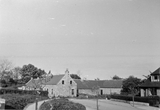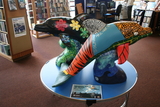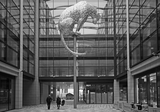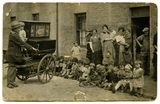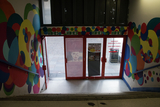|
Quick Search
|
Search Results
You searched for: More Like: 'Leopard spots'
54 items
items as
Brae Farm
1790 This photograph was taken in 1951 by James Kellas and looks east showing, on the left, the rear of Brae Farm, located on Morningside Road, and part of 142 Morningside Avenue on the right.
There was originally a Brae Farm to the north west of this location that can be seen the Ordnance Survey map published in 1869 (Aberdeen Sheet LXXV.14). Just to the north of the old farm on the map is a single Aberdeen Water Works reservoir.
An article from The Leopard magazine by Diane Morgan (October/November 1985) explains that in 1885 an Aberdeen Corporation Water Act was passed to empower the Town Council to take eight million gallons daily from the River Dee and to build a second reservoir at Mannofield. This was to keep up with the city's rapid population increase.
To carry out the expansion, the council acquired the land adjoining the initial reservoir including the first Brae Farmhouse and its steadings. They then became known as Reservoir Cottage and Reservoir House and served as the home of the inspector of the water works. A relatively early inspector was called William Clark. On 28th February 1898 he died at the cottage aged 64. He was buried in the John Knox Churchyard (Aberdeen Weekly Journal, 02/03/1898, p.4).
Clark was likely succeeded as waterworks inspector by James Forsyth. The Forsyth family lived at the cottage well into the 20th century. James was married to Margaret (née Jaffray), who died after him on 28th July 1945, aged 85. Their second son, Sapper John Forsyth, died aged 26 at Oldmill Military Hospital on 20th April 1917. He was buried at Springback Cemetery.
The reservoirs continue to play a vital role in supplying water to Aberdeen. The cottage and house however were demolished in the late 20th century and replaced by modern water treatment buildings.
As shown on the 1901 OS map, sometime shortly after the passing of the 1885 act the Brae Farm we can see in this picture was built to the south east, where Morningside Road met Auchinyell Bridge. To the east, Aberdeenshire County Cricket Ground was also built around the same time.
This later Brae Farm was the home to the Kinnaird family for the first half of the 20th century. The heads of the family were Frank Kinnaird and Margaret Amelia Smith.
Their son Lance-Corporal A. G. Kinnaird, of the Royal Scots, was reported as a prisoner of war in Germany in June 1918. Prior to the war he had worked with the Clydesdale Bank (Evening Express, 03/06/1918 p.3).
Frank's eldest daughter, Jessie Sinclair, married James Smith Mathieson at Ruthrieston U.F. Church on 7th September 1927 (Evening Express, 08/09/1927, p.6).
A younger daughter, Edith Kinnaird, married a man from Portsmouth called Andrew Livingstone in July 1936. The marriage took place in Ruthrieston West Church and the reception was at the Caledonian Hotel (Press & Journal, 06/06/1936 p.8).
Daughters Amelia Elizabeth and Margaret Kinnaird both left Brae Farm in the 1920s (1924 and 1920, respectively) to reunite with fiancés who had travelled ahead to Canada.
Frank Kinnaird died on 12th August 1950, aged 84.
At some point during the 1930s-1950s the residential streets we know today, Morningside Avenue, Terrace and Place were constructed between the reservoir and the new farmstead. These streets take their name from Morningside Farm to the east. As can be seen in this photograph, the farm stood into the 1950s. It was eventually demolished when Morningside Avenue was extended to meet Morningside Road. The newer bungalows can be distinguished by their tiled, rather than slated roofs. A School of Dolphins: Endangered Don the Dolphin at Airyhall Library
2175 Endangered Don the Dolphin was the winning design by two pupils at Mile End School. He was divided up into 6 sections representing different endangered animals - the leopard, tiger, snow leopard, turtle, red admiral butterfly and the blue throated macaw. We chose these as they have distinctive patterns or give colour to the design. The Development of Marischal Square and Broad Street (23/08/2015-20/04/2018): 39
3089 Atrium in Marischal Square. Andy Scott's impressive sculpture of a Leopard perched rather menacingly above a couple of pedestrians. The hut in the distance part of the 2017 Christmas Village. Mackie's 19.2 ice cream parlour on the right. 24/12/2017. Street entertainer
3346 We believe this photograph shows a man historically known as Fool Friday entertaining a group of children and adults outside a house in Aberdeen. Fool Friday was a street vendor who sold ice cream in summer and hot chestnuts in winter. He may have also played a barrel piano as shown here.
Fool Friday was an often seen, distinctive character on the streets of Aberdeen. References to him in recorded oral history and newspapers suggest he sold his goods around the town centre, including at the Castlegate. He appears to have been around in the earlier years of the 20th century, between the two world wars. Little seems to be known, or recorded, about the life of this intriguing figure.
He is mentioned in an article of reminiscences by Arthur Bruce from the Leopard magazine of December 1986/January 1987. Bruce writes "I am reminded of another worthy who lived round the corner in Harriet Street, an Ice Cream Mannie, with a home and family. Of Italian origins he was known as 'Fool Friday' - nothing to do with being stupid, I may add, simply the local dialect for foul or dirty. Legend had it that the nickname was well deserved, but as a child I was never aware of his less than hygienic approach to the business of selling ice cream from a 'cairtie'. I have never solved the mystery of the 'Friday' part, although I should be delighted to hear from anyone who knows the answer."
It is possible that this photograph shows not Fool Friday, but someone else entirely. A letter in the Evening Express of 30th October 1979, looking back to this earlier time, describes a man known as Can-Tam who played a barrel organ in the streets. The letter writer suggests that Can-Tam's organ was smashed by a tram and subsequently replaced by the council.
A suggestion received through social media and subsequent further research indicates that this image may show Guiseppe, or Joseph, Bordone (1872-1957). He was an eating house keeper and an ice-cream and chestnuts vendor. A brief mention in the Evening Express newspaper of 15th March 1994, page 8, suggests that Bordone may have been known as Fool Friday, but this is uncertain.
This photograph was printed as a postcard and these were perhaps sold to the families visited by the entertainer. This postcard was lent to Aberdeen City Libraries by Bill Cheyne so that we could create and preserve a digital copy for public use. Aberdeen Market 9: Hadden Street entrance
4385 A Roddy Millar photograph of the easternmost Hadden Street doors of the Aberdeen Market building. This passageway with stairs came out on to Hadden Street just to the east of the junction with Exchange Street.
The walls have been decorated with multi-coloured spots of varying sizes and the doors feature adverts for Dream Beauty Studio, Combo Café and Restaurant, and Thomson's Quality Butchers.
Photograph taken on 26/02/2019. Treasure 107: Daniel Tickets (1908-1911)
328 This treasure is a collection of twelve event tickets printed by James Daniel & Son between the years 1908 and 1911.
The tickets are all printed on coloured, hard card, roughly 3 inches by 1.5 inches and feature decorative edges. All twelve tickets were printed by James Daniel & Son of 46-48 Castle Street. The company was started in 1835 by James Daniel senior.
This small collection of tickets offers insight into both the work of an important Aberdeen business and the existence of long forgotten social clubs - and they may be one of the few remaining traces of clubs that were once an active part of social life in Aberdeen.
Ten of the tickets are for "Annual Camp-Outs", one is for a picnic and the last is for an "At Home" event. The latter was a social gathering of the early 20th century that involved supper, speeches, music and dancing. The outdoor gatherings took place at scenic spots within easy reach of the city such as Kincorth Wood, Tullos Hill and Persley Den.
Find out more about how the Edwardians spent their leisure time and the scandal surrounding James Daniel's company in the Treasures from our Collections interactive exhibition on our touchscreens. |



